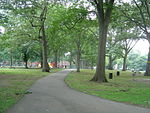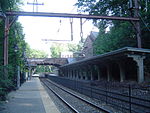Pine Street Historic District (Montclair, New Jersey)
Glen Ridge, New JerseyHistoric districts on the National Register of Historic Places in New JerseyMontclair, New JerseyNRHP infobox with nocatNational Register of Historic Places in Essex County, New Jersey ... and 3 more
New Jersey Register of Historic PlacesNew Jersey Registered Historic Place stubsUse mdy dates from August 2023

The Pine Street Historic District is a 26.6-acre (10.8 ha) historic district encompassing a residential section of the township of Montclair and extending into the borough of Glen Ridge, both in Essex County, New Jersey. It is roughly bounded by Glenridge Avenue, the NJ TRANSIT Boonton Line, Pine and Baldwin Streets. The district, also known as the Montclair Working Class Housing Historic District, was added to the National Register of Historic Places on March 16, 2000 for its significance in architecture and social history. The district includes 107 contributing buildings.
Excerpt from the Wikipedia article Pine Street Historic District (Montclair, New Jersey) (License: CC BY-SA 3.0, Authors, Images).Pine Street Historic District (Montclair, New Jersey)
Grant Street,
Geographical coordinates (GPS) Address Nearby Places Show on map
Geographical coordinates (GPS)
| Latitude | Longitude |
|---|---|
| N 40.809722222222 ° | E -74.207777777778 ° |
Address
Grant Street 6
07042
New Jersey, United States
Open on Google Maps











